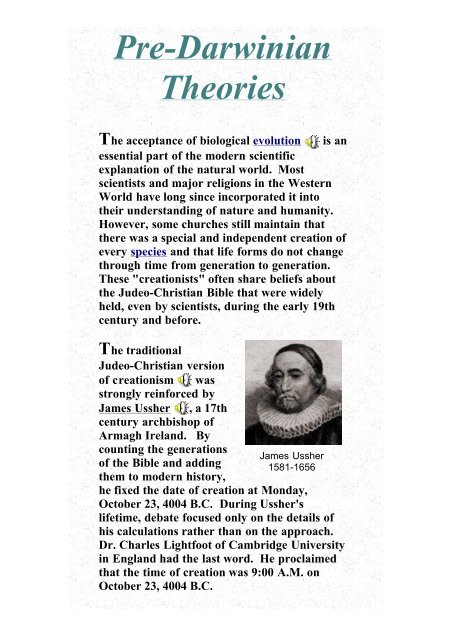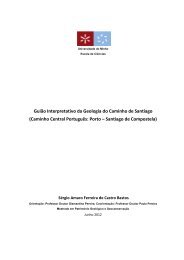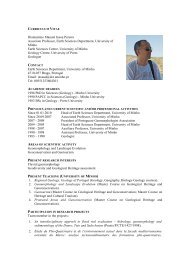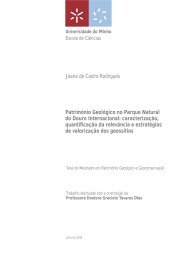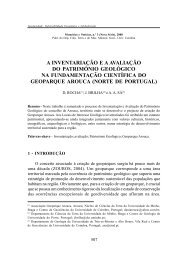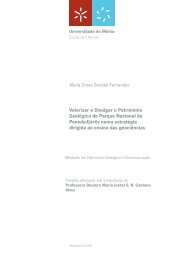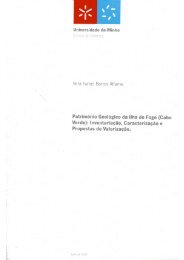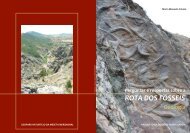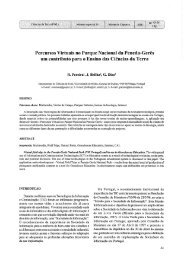Pre-Darwinian Theories
Pre-Darwinian Theories
Pre-Darwinian Theories
Create successful ePaper yourself
Turn your PDF publications into a flip-book with our unique Google optimized e-Paper software.
<strong>Pre</strong>-<strong>Darwinian</strong><br />
<strong>Theories</strong><br />
The acceptance of biological evolution is an<br />
essential part of the modern scientific<br />
explanation of the natural world. Most<br />
scientists and major religions in the Western<br />
World have long since incorporated it into<br />
their understanding of nature and humanity.<br />
However, some churches still maintain that<br />
there was a special and independent creation of<br />
every species and that life forms do not change<br />
through time from generation to generation.<br />
These "creationists" often share beliefs about<br />
the Judeo-Christian Bible that were widely<br />
held, even by scientists, during the early 19th<br />
century and before.<br />
The traditional<br />
Judeo-Christian version<br />
of creationism was<br />
strongly reinforced by<br />
James Ussher , a 17th<br />
century archbishop of<br />
Armagh Ireland. By<br />
counting the generations<br />
of the Bible and adding<br />
them to modern history,<br />
he fixed the date of creation at Monday,<br />
October 23, 4004 B.C. During Ussher's<br />
James Ussher<br />
1581-1656<br />
lifetime, debate focused only on the details of<br />
his calculations rather than on the approach.<br />
Dr. Charles Lightfoot of Cambridge University<br />
in England had the last word. He proclaimed<br />
that the time of creation was 9:00 A.M. on<br />
October 23, 4004 B.C.
his belief that the Earth and life on it are<br />
only about 6000 years old fit neatly with the<br />
then prevalent theory of the "Great Chain of<br />
Being." This held that God created an infinite<br />
and continuous series of life forms, each one<br />
grading into the next, from simplest to most<br />
complex, and that all organisms, including<br />
humans, were created in their present form<br />
relatively recently and that they have remained<br />
unchanged since then. Given these strongly<br />
held beliefs, it is not surprising that 17th and<br />
18th century European biology consisted<br />
mainly of the description of plants and animals<br />
as they are with virtually no attempt to explain<br />
how they got that way.<br />
The leading biological<br />
scientist of the 18th century<br />
was the Swedish botanist<br />
Karl von Linné (Carolus<br />
Linnaeus in Latin). His<br />
180 books are filled with<br />
precise descriptions of<br />
nature, but he did little<br />
analysis or interpretation.<br />
This is to be expected since<br />
Carolus Linnaeus<br />
1707-1778<br />
Linnaeus apparently believed that he was just<br />
revealing the unchanging order of life created<br />
by God. The goal of documenting change in<br />
nature would not have made sense to him.<br />
Late in his life, however, he was troubled by<br />
the fact that plant hybrids could be created by<br />
cross pollination. These were varieties that had<br />
not existed before. Linnaeus stopped short of<br />
concluding that these plants had evolved.<br />
Despite his limiting research bias, Linnaeus<br />
was a first class scientist. His most important<br />
contribution to science was his logical<br />
classification system for all living things. He<br />
described plants and animals on the basis of
physical appearance and classified them<br />
relative to each other according to the degree<br />
of their similarities. He used a binomial<br />
nomenclature in naming them. That is to<br />
say, organisms were given two Latin<br />
names--genus and species . Each genus<br />
could have many related species. Each genus<br />
was also part of larger categories of living<br />
things.<br />
genus<br />
genus<br />
species species species species<br />
The concept of genus and species was actually<br />
developed a generation earlier by John Ray, an<br />
English naturalist and ordained minister.<br />
However, it was Linnaeus who used this system<br />
to name us Homo sapiens (literally, "wise<br />
men"). This was very controversial at the time<br />
since it implied that people were part of<br />
nature, along with other animals and plants.<br />
Late in the 18th century,<br />
a small number of<br />
European scientists began<br />
to quietly suggest that life<br />
forms are not fixed. The<br />
French zoologist, George<br />
Louis Leclerc, Comte de<br />
Buffon , actually said Comte de Buffon<br />
that living things do<br />
1707-1788<br />
change through time and that the Earth must<br />
be much older than 6000 years. In 1774, in<br />
fact, he speculated that the Earth must be at<br />
least 75,000 years old. The Count of Buffon<br />
was careful to hide his views in a 44 volume<br />
natural history book series. By doing this, he<br />
avoided broad public criticism.<br />
While the Count of Buffon was a quiet
pioneer in asserting that species can change<br />
over generations, he rejected the idea that<br />
species could evolve into other species.<br />
Erasmus Darwin<br />
1731-1802<br />
Another late 18th century<br />
closet-evolutionist was<br />
Erasmus Darwin , the<br />
grandfather of Charles<br />
Darwin. Erasmus was an<br />
English country physician,<br />
poet, and amateur<br />
scientist. He believed that<br />
evolution has occurred in<br />
living things including<br />
humans. He wrote of this in his poems and<br />
other relatively obscure publications.<br />
However, like the Count of Buffon, he did not<br />
know what caused evolution.<br />
The first evolutionist who<br />
confidently and very<br />
publicly stated his ideas<br />
about the processes<br />
leading to biological<br />
change was another late<br />
18th and early 19th<br />
century French aristocrat,<br />
Jean Baptiste, Chevalier of<br />
Lamarck<br />
Lamarck<br />
1744-1829<br />
. Unfortunately, his theory about<br />
these processes was entirely incorrect.<br />
Lamarck's conception<br />
Lamarck believed that<br />
microscopic organisms<br />
appear spontaneously from<br />
inanimate materials and<br />
then evolve progressively<br />
into more complex forms<br />
through a constant striving<br />
for perfection. The<br />
ultimate product of this<br />
goal-oriented evolution was
thought by Lamarck to be<br />
humans. He believed that evolution was mostly<br />
due to the the inheritance of acquired<br />
characteristics. That is, he believed that<br />
evolution occurs when an organism uses a body<br />
part in such a way that it is altered during its<br />
lifetime and this change is then inherited by its<br />
offspring. For example, Lamarck thought that<br />
giraffes evolved their long necks by each<br />
generation stretching further to get leaves in<br />
trees and that this change in body shape was<br />
then inherited. Likewise, he believed that<br />
wading birds, such as herons and egrets,<br />
evolved their long legs by stretching them to<br />
remain dry generation after generation.<br />
Lamarck also believed that creatures could<br />
develop new organs or change the structure<br />
and function of old ones as a result of their use<br />
or disuse.<br />
It was relatively easy for the French scientist,<br />
George Cuvier , and other critics of<br />
Lamarck to discredit his ideas of inheritance of<br />
acquired characteristics. If this theory were<br />
correct, the children of cowboys who have<br />
developed bowed legs as a result of a lifetime of<br />
riding horses would be born with bowed legs as<br />
well. That, of course, does not occur.<br />
Likewise, the children of professional weight<br />
lifters are not born with enlarged muscles.<br />
While Lamarck's<br />
explanation of evolution was<br />
incorrect, it is unfair to label<br />
him a bad scientist. In fact,<br />
he was at the cutting edge of<br />
biological research for his<br />
time. He also was largely<br />
responsible for making<br />
biology a distinct branch of<br />
science.<br />
George Cuvier<br />
1769-1832
Despite his criticism of Lamarck, George<br />
Cuvier did not reject the idea that there had<br />
been earlier life forms. In fact, he was the first<br />
scientist to document extinctions of ancient<br />
animals. However, he rejected the idea that<br />
their existence implied that evolution had<br />
occurred--he rigidly maintained the "fixity" of<br />
species.<br />
Cuvier advocated the theory of catastrophism<br />
. This held that there have been violent and<br />
sudden natural catastrophes such as great<br />
floods and the rapid formation of major<br />
mountain chains. Plants and animals living in<br />
those parts of the world where such events<br />
occurred were often killed off according to<br />
Cuvier. Then new life forms moved in from<br />
other areas. As a result, the fossil record for a<br />
region shows abrupt changes in species.<br />
Charles Lyell<br />
1797-1875<br />
A careful examination of<br />
European geological<br />
deposits led the English<br />
scientist, Charles Lyell ,<br />
to conclude that Cuvier's<br />
catastrophism theory was<br />
wrong. He believed that<br />
there primarily have been<br />
slower, progressive<br />
changes. Lyell<br />
documented the fact that the Earth must be<br />
very old and that it has been subject to the<br />
same sort of natural processes in the past that<br />
operate today in shaping the land. These<br />
forces include erosion, earthquakes, glacial<br />
movements, volcanoes, and even the<br />
decomposition of plants and animals.<br />
Lyell provided conclusive evidence for the<br />
theory of uniformitarianism , which had<br />
been developed originally by the late 18th
century Scottish geologist, James Hutton. This<br />
held that the natural forces now changing the<br />
shape of the Earth's surface have been<br />
operating in the past much the same way. In<br />
other words, the present is the key to<br />
understanding the past.<br />
This revolutionary idea was instrumental in<br />
leading Charles Darwin to his understanding<br />
of biological evolution in the 1830's. However,<br />
it was not until the late 19th century that most<br />
educated people in the Western world finally<br />
rejected the theory of catastrophism in favor of<br />
uniformitarianism.<br />
Today, we know that our planet has been<br />
shaped by occasional catastrophic events, such<br />
as bombardment of large meteors, in addition<br />
to the comparatively slower natural processes<br />
suggested by uniformitarianism. All of these<br />
events have potentially affected the rate and<br />
direction of biological evolution.<br />
Return to Menu Practice Quiz Next Topic<br />
This page was last updated on Wednesday, October 01, 2003.<br />
Copyright © 1998-2002 by Dennis O'Neil. All rights reserved.<br />
Illustration credits
Darwin and<br />
Natural Selection<br />
Most educated people in Europe and the<br />
Americas during the 19th century had their<br />
first full exposure to the concept of evolution<br />
through the writings of Charles Darwin .<br />
Clearly, he did not invent the idea. That<br />
happened long before he was born. However,<br />
he carried out the necessary research to<br />
conclusively document that evolution has<br />
occurred and then made the idea acceptable<br />
for scientists and the general public. This was<br />
not easy since the idea of evolution had been<br />
strongly associated with radical scientific and<br />
political views coming out of<br />
post-revolutionary France. These ideas were<br />
widely considered to be a threat to the<br />
established order in Britain.<br />
Charles Darwin was born<br />
into a moderately wealthy<br />
family in Shrewsbury,<br />
England. His father,<br />
Robert, had the largest<br />
medical practice outside of<br />
London at the time and his<br />
mother, Susannah<br />
Wedgwood, was from a<br />
family of wealthy pottery<br />
manufacturers. Charles<br />
Charles Darwin<br />
1809-1882<br />
grew up in comparative luxury in a large house<br />
with servants. However, this was a socially<br />
very conservative time in England that set<br />
narrow limits on a young man's behavior and<br />
future possibilities. The constraints on women<br />
in Darwin's social class were even greater.<br />
Most were given only enough education to<br />
efficiently manage the homes of their future<br />
husbands and raise their children. Young men
were expected to go to university in order to<br />
prepare themselves to become medical doctors,<br />
military officers, or religious leaders in the<br />
Church of England. Most other occupations<br />
were considered somewhat unsavory.<br />
Darwin started university at 16 in Edinburgh<br />
as a medical student. He showed little<br />
academic interest and dropped out after two<br />
years (1825-7). He then went to Cambridge<br />
University to study theology. It was there that<br />
his life's direction took a radical change. He<br />
became very interested in the scientific ideas of<br />
the geologist Adam Sedgwick and especially the<br />
naturalist John Henslow with whom he spent<br />
considerable time collecting specimens from<br />
the countryside around the university. Darwin<br />
also was influenced by the writings of the late<br />
18th century evolutionists, including his<br />
grandfather, Erasmus.<br />
Following graduation from Cambridge with a<br />
degree in theology, Darwin was clearly more<br />
interested in biology than he was in a clerical<br />
career. Fortunately, John Henslow was able to<br />
help him secure a birth on a British Navy<br />
mapping expedition that was going around the<br />
world on a five year long voyage. Darwin<br />
sailed in 1831 on the ship H.M.S. Beagle as an<br />
unpaid naturalist and companion for the<br />
captain, Robert Fitzroy. Darwin was only 22<br />
years old at the time. The Beagle was a<br />
compact 90 feet long ship with a crew of 74.<br />
There was little space, even for the captain. It<br />
was during the beginning of this voyage that<br />
Darwin read the early books of Charles Lyell<br />
and became convinced by his proof that<br />
uniformitarianism provided the correct<br />
understanding of the Earth's geological<br />
history. This intellectual preparation along<br />
with his research on the voyage were critical in<br />
leading Darwin to understand evolution.<br />
Especially important to the development of this<br />
understanding was his visit to the Galápagos
Islands in the Eastern Pacific Ocean. It<br />
was there that he began to comprehend what<br />
causes plants and animals to evolve.<br />
Five year voyage of H.M.S. Beagle (1831-1836)<br />
The Galápagos<br />
Islands have<br />
species found in<br />
no other part of<br />
the world, though<br />
similar ones exist<br />
in South<br />
America. Darwin<br />
was struck by the<br />
fact that the birds<br />
were slightly<br />
different from<br />
one island to<br />
another. He<br />
realized that the<br />
key to why this<br />
difference existed<br />
was connected<br />
with the fact that the various species live in<br />
different kinds of environments.<br />
Darwin identified 13 species of finches in the<br />
Galápagos Islands. This was puzzling since he<br />
knew of only one species of this bird on the<br />
mainland of South America, 600 miles to the<br />
east, where they had all presumably<br />
originated. He observed that the Galápagos
species differed from each other in beak<br />
shape. He also noted that the beak varieties<br />
were associated with diets based on different<br />
foods. He concluded that when the original<br />
South American finches reached the islands,<br />
they dispersed to different environments where<br />
they had to adapt to different conditions. Over<br />
many generations, they changed anatomically<br />
in ways that allowed them to get enough food<br />
and survive to reproduce.<br />
Finches from the Galápagos Islands<br />
Today we use the term adaptive radiation to<br />
refer to this sort of branching evolution in<br />
which different populations of a species<br />
become reproductively isolated from each<br />
other by adapting to different ecological niches<br />
and eventually become separate species.<br />
Darwin came to understand that any<br />
population consists of individuals that are all<br />
slightly different from one another. Those<br />
individuals having a variation that gives them<br />
an advantage in staying alive long enough to<br />
successfully reproduce are the ones that pass<br />
on their traits more frequently to the next<br />
generation. Subsequently, their traits become<br />
more common and the population evolves.<br />
Darwin called this "descent with<br />
modification."
The Galápagos finches provide an excellent<br />
example of this process. For instance, among<br />
the birds that ended up in arid environments,<br />
the ones with beaks that were better suited for<br />
eating cactus got more food. As a result, they<br />
were in better condition to mate. In a very real<br />
sense, nature selected the best adapted<br />
varieties to survive and to reproduce. This<br />
process has come to be known as natural<br />
selection.<br />
Darwin did not believe that the environment<br />
was producing the variation within the finch<br />
populations. He correctly thought that the<br />
variation already existed and that nature just<br />
selected for the most suitable beak shape and<br />
against less useful ones. Darwin and his<br />
supporters ultimately described this process as<br />
the "survival of the fittest." This is very<br />
different from Lamarck's incorrect idea that<br />
the environment altered the shape of<br />
individuals and that these acquired changes<br />
were then inherited.<br />
Nineteenth century critics of Darwin thought<br />
that he had misinterpreted the Galápagos finch<br />
data. They said that God had created the 13<br />
different species as they are and that no<br />
evolution in beak shape has ever occurred. It<br />
was difficult to conclusively refute such<br />
counter arguments at that time. However,<br />
20th century field research has proven Darwin<br />
to be correct.<br />
In 1798, Thomas Malthus<br />
, an English clergyman<br />
and pioneer economist,<br />
published an extensive<br />
article entitled Essay on the<br />
Principles of Population.<br />
In it he observed that<br />
human populations will<br />
double every 25 years
unless they are kept in<br />
(1766-1834)<br />
check by limits in food<br />
supply. By the late 1830's, Darwin came to<br />
realize that all plant and animal populations<br />
have this same potential to rapidly increase<br />
their numbers unless they are constantly<br />
checked by limitations in food, water, and<br />
other resources that are essential for survival.<br />
This fact was key to his understanding of the<br />
process of natural selection. He realized that<br />
the most fit individuals in a population are the<br />
ones that are least likely to die of starvation<br />
and, therefore, are most likely to pass on their<br />
traits to the next generation.<br />
Who Was Charles Darwin--video clip from<br />
PBS 2001 series Evolution<br />
Requires RealPlayer to view (length = 6<br />
mins, 26 secs)<br />
A good example of natural selection was<br />
discovered among "peppered" moths living<br />
near English industrial cities. These insects<br />
have varieties that vary in wing and body<br />
coloration from light to dark. During the 19th<br />
century, sooty smoke from coal burning<br />
furnaces killed the lichen on trees and<br />
darkened the bark. When moths landed on<br />
these trees, the dark colored ones were harder<br />
to spot by birds who ate them and,<br />
subsequently, they more often lived long<br />
enough to reproduce. Over generations, the<br />
environment continued to favor darker moths.<br />
As a result, they progressively became more<br />
common. By 1895, 98% of the moths in the<br />
vicinity of English cities like Manchester were<br />
mostly black. Since the 1950's, air pollution<br />
controls have significantly reduced the amount<br />
of heavy particulate air pollutants reaching the<br />
trees. As a result, lichen has grown back,<br />
making trees lighter in color. Now, natural
selection favors lighter moth varieties so they<br />
have become the most common. This trend has<br />
been well documented by field studies<br />
undertaken between 1959 and 1995 by Sir<br />
Cyril Clarke from the University of Liverpool.<br />
The same pattern of moth wing color<br />
evolutionary change in response to increased<br />
and later decreased atmospheric pollution has<br />
been carefully documented by other<br />
researchers for the countryside around Detroit,<br />
Michigan.<br />
Dark moths on light colored bark are easy targets for<br />
hungry birds but are hidden on pollution darkened<br />
trees.<br />
Evolution of Camouflage: another example<br />
of natural selection in the insect world<br />
This link takes you to a video at an external<br />
website. To return here, you must click the<br />
"back" button on your browser<br />
program. (length = 58 secs)<br />
Toxic Newts: the evolutionary arms race<br />
between predator and prey driving evolution<br />
This link takes you to a video at an external<br />
website. To return here, you must click the<br />
"back" button on your browser<br />
program. (length = 5 mins, 28 secs)<br />
Darwin did not rush his ideas about natural<br />
selection into print. There was a Christian<br />
evangelical fervor in England at the time. He
could have been charged with sedition and<br />
blasphemy for publishing his unpopular<br />
theory. After returning from the voyage<br />
around the world on H.M.S. Beagle, he settled<br />
down in England, married Emma Wedgwood<br />
(his first cousin), raised a large family, and<br />
quietly continued his research. In 1842 and<br />
1844, he wrote relatively short summaries of<br />
his theory, but they were not widely read<br />
outside of British scientific circles. It was not<br />
until he was 50 years old, in 1859, that he<br />
finally published his theory of evolution in full<br />
for his fellow scientists and for the public at<br />
large. He did so in a book entitled On the<br />
Origin of Species. It was very popular and<br />
controversial from the outset. The first edition<br />
came out on November 24, 1859 and sold out<br />
on that day. It went through six editions by<br />
1872.<br />
What finally convinced<br />
Darwin that he should<br />
publish his theory was<br />
the draft of an essay that<br />
he received in the<br />
summer of 1858 from a<br />
younger British<br />
naturalist named Alfred<br />
Wallace , who was<br />
then hard at work<br />
collecting biological<br />
specimens in Southeast Asia for sale to<br />
Alfred Wallace<br />
1823-1913<br />
museums and private collectors. Darwin was<br />
surprised to read that Wallace had come upon<br />
essentially the same explanation for evolution.<br />
Being a fair man, Darwin later insisted that<br />
Wallace also get credit for the theory during<br />
debates over its validity carried out by the<br />
British Royal Society. We now know that<br />
Darwin deserves most of the credit. In 1837,<br />
one year after he returned from the voyage on<br />
the Beagle, he made detailed notes on the idea<br />
of evolution by means of natural selection. At<br />
that time Wallace was only 14. In addition, it
was Darwin's book, rather than Wallace's<br />
essay, that had the most impact on the<br />
Victorian public. Darwin not only described<br />
the process of natural selection in more detail,<br />
but he also gave numerous examples of it. It<br />
was his On the Origin of Species that convinced<br />
most educated people in the late 19th century<br />
that life forms do change through time. This<br />
prepared the public for the acceptance of<br />
earlier human species and of a world much<br />
older than 6000 years.<br />
Darwin and Victorian Culture--interview with<br />
Darwin's biographer, James Moore<br />
This link takes you to an audio file at an<br />
external website. To return here, you must click<br />
the "back" button on your browser<br />
program. (length = 8 mins, 5 secs)<br />
Both Darwin and Wallace<br />
failed to understand an<br />
important aspect of natural<br />
selection. They realized that<br />
plant and animal<br />
populations are composed of<br />
individuals that vary from<br />
each other in physical form.<br />
They also understood that<br />
nature selects from the<br />
existing varieties those traits<br />
that are most suited to their<br />
Gregor Mendel<br />
1822-1884<br />
environment. If natural selection were the only<br />
process occurring, each generation should have<br />
less variation until all members of a population<br />
are essentially identical, or clones of each<br />
other. That does not happen. Each new<br />
generation has new variations. Darwin was<br />
aware of this fact, but he did not understand<br />
what caused the variation. The first person to<br />
begin to grasp why this happens was an<br />
obscure Central European monk named<br />
Gregor Mendel . Through plant breeding<br />
experiments carried out between 1856 and<br />
1863, he discovered that there is a
ecombination of parental traits in offspring.<br />
Sadly, Darwin and most other 19th century<br />
biologists never knew of Mendel and his<br />
research. It was not until the beginning of the<br />
20th century that Mendel's pioneer research<br />
into genetic inheritance was rediscovered. This<br />
was long after his death. He never received<br />
the public acclaim that was eventually<br />
showered on Darwin.<br />
Charles Darwin's convincing evidence that<br />
evolution occurs was very threatening to many<br />
Christians who believed that people were<br />
created specially by God and that they have<br />
not changed biologically since that creation.<br />
The idea that there could have been prehistoric<br />
humans who were anatomically different from<br />
us was rejected for similar reasons. However,<br />
Charles Lyell's geological evidence that the<br />
Earth must be much older than 6,000 years<br />
and the rapidly accumulating fossil record of<br />
past evolution convinced educated lay people<br />
in the 1860's to think what had been<br />
unthinkable earlier.<br />
Archaeological<br />
confirmation of the<br />
existence of prehistoric<br />
Europeans had been<br />
accumulating since the<br />
1830's. However, until the<br />
late 1850's, it had been<br />
widely rejected or<br />
Boucher de Perthes misinterpreted. Much of<br />
(1788-1868) this evidence had been<br />
collected by Jacques Boucher Crèvecoeur de<br />
Perthes , a customs officer in northern<br />
France in the early 1800's. His hobby was<br />
collecting ancient stone tools from deep down<br />
in the Somme River gravel deposits. Since he<br />
found these artifacts in association with the<br />
bones of extinct animals, he concluded that<br />
they must have been made at the time that<br />
those animals lived.
Boucher de<br />
Perthes tried<br />
to publish his<br />
findings in<br />
1838. They<br />
were rejected<br />
by all<br />
important<br />
scientists and<br />
journals. The<br />
prehistoric<br />
stone tools<br />
<strong>Pre</strong>historic artifact incorrectly thought<br />
to be a "lightning bolt remnant"<br />
usually were dismissed as being only "lightning<br />
stones" (i.e., the remnants of lightning bolts).<br />
However, by 1858, his claims were beginning to<br />
be accepted by some enlightened Western<br />
European scientists. Darwin's publication of<br />
On the Origin of Species the following year<br />
convinced even more educated people that<br />
Boucher de Perthes had been right.<br />
Darwin's popularizing the idea of evolution<br />
also made it possible for scientists to begin to<br />
accept that some of the makers of Boucher de<br />
Perthes' prehistoric tools had already been<br />
discovered and that their bones were in<br />
museums. These bones had been found in<br />
several Western European countries during the<br />
first half of the 19th century. However, they<br />
had all been dismissed as being from odd<br />
looking modern people. During the 1860's,<br />
some were correctly determined to be from an<br />
earlier species or variety of people who had<br />
lived during the last ice age--i.e., long before<br />
recorded history. We now know that these<br />
ancient people were mostly Neandertals, who<br />
lived about 130,000-29,000 years ago.<br />
<strong>Pre</strong>vious<br />
Topic<br />
Return to<br />
Menu<br />
Practice<br />
Quiz<br />
Next<br />
Topic<br />
This page was last updated on Friday, August 22, 2003.
Copyright © 1998-2003 by Dennis O'Neil. All rights reserved.<br />
Illustration credits
Evidence of<br />
Evolution<br />
The Nobel Prize winning scientist Linus<br />
Pauling aptly described science as the search<br />
for truth. Science does this by continuously<br />
comparing its theories objectively with<br />
evidence in the natural world. When theories<br />
no longer conform to the evidence, they are<br />
modified or rejected in favor of new theories<br />
that do conform. In other words, science<br />
constantly tries to prove its assumptions to be<br />
false and rejects implausible explanations. In<br />
this way, scientific knowledge and<br />
understanding grow over time. Religious<br />
explanations for the order of things are not<br />
science because they are based primarily on<br />
faith and do not subject themselves to be<br />
objectively falsified. Because of this<br />
fundamental difference in the approach to<br />
understanding the natural world, the U.S.<br />
Supreme Court decided in 1987 that the<br />
Biblically based "Creation Science" is not a<br />
science and cannot be taught as such in public<br />
schools as an alternative or in addition to the<br />
mainstream evolutionary theory of the<br />
biological sciences. However, religious creation<br />
stories can be taught in philosophy, religion, or<br />
history courses. Religion and Science provide<br />
different approaches to knowledge. It is<br />
important to understand both.<br />
Isn't Evolution Just a Theory--video clip<br />
from PBS 2001 series Evolution<br />
Requires RealPlayer to view (length = 6<br />
mins, 15 secs)
What is Evolution<br />
Biological evolution is genetic change in a<br />
population from one generation to another.<br />
The speed and direction of change is variable<br />
with different species lines and at different<br />
times. However, continuous evolution over<br />
many generations can result in the<br />
development of new varieties and species.<br />
Likewise, failure to evolve in response to<br />
environmental changes can, and often does,<br />
lead to extinction.<br />
When scientists speak of evolution as a theory<br />
they do not mean that it is a mere speculation.<br />
It is a theory in the same sense as the<br />
propositions that the Earth is round rather<br />
than flat or that our bodies are made of atoms<br />
are theories. Most people would consider such<br />
fundamental theories to be sufficiently tested<br />
by empirical evidence to conclude that they are<br />
indeed facts. As a result of the massive amount<br />
of evidence for evolution accumulated over the<br />
last two centuries, we can safely conclude that<br />
evolution has occurred and continues to occur.<br />
All life forms, including people, evolved from<br />
earlier species. Furthermore, all still living<br />
populations of organisms continue to evolve<br />
today. We now understand that there are a<br />
number of different natural processes that can<br />
cause evolution to occur. These are presented<br />
in later tutorials of this series.<br />
For those who have difficulty in accepting<br />
evolution because of what they perceive as<br />
contradictions with their fundamental religious<br />
beliefs, it may be useful to distinguish the<br />
ultimate origin of life from its later evolution.<br />
Many, if not most, biological scientists accept<br />
that primordial life on Earth began as a result<br />
of chance natural occurrences 3.5-4 billion<br />
years ago. However, it is not necessary to<br />
believe in that view in order to accept that
living creatures evolved by natural means after<br />
the origin of the first life. As far as we know,<br />
Charles Darwin modified his religious beliefs,<br />
as did many others, as a result of the discovery<br />
of convincing proof of evolution. Darwin's<br />
religious faith was also severely challenged by<br />
the death of his 10 year old daughter Annie in<br />
1851. Apparently, he came to believe that his<br />
God created the order of the universe<br />
including the rules of nature that result in<br />
biological evolution. His famous book, On the<br />
Origin of Species, was not a denial of his God's<br />
existence. However, he did reject a literal<br />
interpretation of the Judeo-Christian Bible.<br />
Darwin's Personal Struggles--an interview<br />
with Darwin's biographer, James Moore<br />
This link takes you to an audio file at an<br />
external website. To return here, you must click<br />
the "back" button on your browser<br />
program. (length = 7 mins, 38 secs)<br />
Evolution of the Eye--an explanation by<br />
zoologist Dan-Erik Nilsson<br />
This link takes you to a video at an external<br />
website. To return here, you must click the<br />
"back" button on your browser<br />
program. (length = 4 mins, 8 secs)<br />
How Do We Know<br />
That Evolution Has<br />
Occurred<br />
The evidence for evolution has primarily come<br />
from four sources:<br />
1. the fossil record of change in earlier species<br />
2. the chemical and anatomical similarities of<br />
related life forms<br />
3. the recorded genetic changes in living
organisms over many generations<br />
4. the geographic distribution of related<br />
species<br />
The Fossil Record<br />
Remains of<br />
animals and<br />
plants found in<br />
sedimentary<br />
rock deposits<br />
give us an<br />
indisputable<br />
record of past<br />
changes through<br />
time. This<br />
evidence attests<br />
to the fact that<br />
there has been a<br />
tremendous<br />
variety of living things. Some now extinct<br />
species had traits that were transitional<br />
between major groups of organisms. Their<br />
existence confirms that species are not fixed<br />
but can evolve into other species over time.<br />
Geological strata containing an<br />
evolutionary sequence of fossils<br />
The evidence also shows that what have<br />
appeared to be gaps in the fossil record are due<br />
to incomplete data collection. The more that<br />
we learn about the evolution of specific species<br />
lines, the more that these so-called gaps or<br />
"missing links in the chain of evolution" are<br />
filled with transitional fossil specimens.<br />
Chemical and Anatomical<br />
Similarities<br />
Living things on Earth are fundamentally<br />
similar in the way that their basic anatomical<br />
structures develop and in their chemical
compositions. No matter whether they are<br />
simple single celled protozoa or highly<br />
complex organisms with billions of cells, they<br />
all begin as single cells that reproduce<br />
themselves by similar division processes. After<br />
a limited life span, they also all grow old and<br />
die.<br />
All living things on Earth share the ability to<br />
create complex molecules out of carbon and a<br />
few other elements. In fact, 99% of the<br />
proteins, carbohydrates, fats, and other<br />
molecules of living things are made from only 6<br />
of the 92 most common elements. This is not a<br />
mere coincidence.<br />
All plants and animals receive their specific<br />
characteristics from their parents by inheriting<br />
particular combinations of genes. Molecular<br />
biologists have discovered that genes are, in<br />
fact, segments of DNA molecules in our<br />
cells.<br />
section of a DNA molecule<br />
These segments of DNA are chemically coded<br />
recipes for creating proteins by linking<br />
together particular amino acids in specific<br />
sequences.<br />
simple protein molecule<br />
All of the tens of thousands of types of
proteins in living things are made of only 20<br />
kinds of amino acids. Despite the great<br />
diversity of life on our planet, the simple<br />
language of the DNA code is the same for all<br />
living things. This is evidence of the<br />
fundamental molecular unity of life.<br />
In addition to molecular similarities, most<br />
living things are alike in that they either get<br />
the energy needed for growth, repair, and<br />
reproduction directly from sunlight, by<br />
photosynthesis , or they get it indirectly by<br />
consuming green plants and other organisms<br />
that eat plants.<br />
Many groups of<br />
species share the same<br />
types of body structures<br />
because they inherited<br />
them from a common<br />
ancestor that had them.<br />
This is the case with the<br />
vertebrates , which<br />
are the animals that<br />
have internal skeletons.<br />
The arms of humans,<br />
the forelegs of dogs and<br />
cats, the wings of birds,<br />
Human arm bones<br />
(typical vertebrate pattern)<br />
and the flippers of whales and seals all have the<br />
same types of bones (humerus, radius, and<br />
ulna) because they have retained these traits of<br />
their shared common ancient vertebrate<br />
ancestor.<br />
All of these major chemical and anatomical<br />
similarities between living things can be most<br />
logically accounted for by assuming that they<br />
either share a common ancestry or that they<br />
came into existence as a result of similar<br />
natural processes. These facts make it difficult<br />
to accept a theory of special and independent<br />
creation of different species.
Geographic Distribution of<br />
Related Species<br />
Another clue to patterns of past evolution is<br />
found in the natural geographic distribution of<br />
related species. It is clear that major isolated<br />
land areas and island groups often evolved<br />
their own distinct plant and animal<br />
communities. For instance, before humans<br />
arrived 60-40,000 years ago, Australia had<br />
more than 100 species of kangaroos, koalas,<br />
and other marsupials but none of the more<br />
advanced terrestrial placental mammals<br />
such as dogs, cats, bears, and horses. Land<br />
mammals were entirely absent from the even<br />
more isolated islands that make up Hawaii and<br />
New Zealand. Each of these places had a great<br />
number of plant, insect, and bird species that<br />
were found nowhere else in the world. The<br />
most likely explanation for the existence of<br />
Australia's, New Zealand's, and Hawaii's<br />
mostly unique biotic environments is that the<br />
life forms in these areas have been evolving in<br />
isolation from the rest of the world for millions<br />
of years.<br />
Genetic Changes Over<br />
Generations<br />
The Earth's environments are constantly<br />
changing, usually in subtle and complex ways.<br />
When the changes are so great as to go beyond<br />
what most members of a population of<br />
organisms can tolerate, death occurs. As<br />
Charles Darwin observed, however, not all<br />
individuals always perish. Fortunately, natural<br />
populations have genetic diversity. Those<br />
individuals whose characteristics allow them to<br />
survive an environmental crisis likely will be<br />
the only ones able to reproduce.
Subsequently, their traits will be more common<br />
in the next generation--evolution of the<br />
population will have occurred.<br />
This process of natural selection resulting in<br />
evolution can be easily demonstrated over a 24<br />
hour period in a Petri dish of bacteria living in<br />
a nutrient medium. When a lethal dose of<br />
antibiotic is added, there will be a mass die-off.<br />
However, a few of the bacteria usually are<br />
immune and survive. The next generation is<br />
mostly immune because they have inherited<br />
immunity from the survivors. That is the case<br />
with the purple bacteria in the Petri dishes<br />
shown below--the bacteria population has<br />
evolved.<br />
Evolution of antibiotic resistant bacteria<br />
This same phenomenon of bacteria evolution<br />
speeded up by human actions occurs in our<br />
own bodies at times when an antibiotic drug is<br />
unable to completely eliminate a bacterial<br />
infection. That is the reason that medical<br />
doctors are sometimes hesitant to recommend<br />
an antibiotic for their patients and insist that<br />
the full dosage be used even if the symptoms of<br />
illness go away. They do not want to allow any<br />
potentially antibiotic resistant bacteria to<br />
survive.<br />
People have developed<br />
many new varieties of<br />
plants and animals by<br />
selective breeding.
This process is similar<br />
to the bacteria<br />
experiment described<br />
above. Selection of<br />
specimens to breed<br />
Insect with a high<br />
reproductive potential<br />
Dog variety resulting from<br />
selective breeding over<br />
many generations<br />
based on particular traits is, in effect, changing<br />
the environment for the population. Those<br />
individuals lacking the desirable characteristics<br />
are not allowed to breed. Therefore, the<br />
following generations more commonly have the<br />
desired traits.<br />
Species that mature<br />
and reproduce large<br />
numbers in a short<br />
amount of time have a<br />
potential for very fast<br />
evolutionary changes.<br />
Insects and<br />
microorganisms often<br />
evolve at such rapid rates that our actions to<br />
combat them quickly lose their effectiveness.<br />
We must constantly develop new pesticides,<br />
antibiotics, and other measures in an ever<br />
escalating biological arms race with these<br />
creatures. Unfortunately, there are a few<br />
kinds of insects and microbes that are now<br />
significantly or completely resistant to our<br />
counter measures, and some of these species<br />
are responsible for devastating crop losses and<br />
deadly diseases.<br />
Antibiotic resistance--how mutation and fast<br />
reproductive rates of<br />
microorganisms can outpace modern<br />
medical breakthroughs<br />
This link takes you to an external website. To<br />
return here, you must click<br />
the "back" button on your browser program.<br />
If evolution has occurred, there should be<br />
many anatomical similarities among varieties<br />
and species that have diverged from a common<br />
ancestor. Those species with the most recent
common ancestor should share the most traits.<br />
The fact that wolves, dogs, and other members<br />
of the genus Canis are anatomically very<br />
similar, for instance, is due to the fact that they<br />
are descended from the same ancient canine<br />
species. Wolves and dogs also share<br />
similarities with foxes, indicating a slightly<br />
more distant ancestor with them.<br />
Genetic Tool Kit--evidence of a common set of genes for<br />
body parts shared by<br />
many, if not most, creatures<br />
This link takes you to a video at an external website. To<br />
return here, you must click the<br />
"back" button on your browser program. (length =<br />
4 mins, 47 secs)<br />
Science and Faith--roundtable discussion about<br />
resolving conflicts with religion<br />
This link takes you to an external website. To return here,<br />
you must click the "back"<br />
button on your browser program.<br />
Evolving Ideas: Why Is Evolution Controversial<br />
Anyway--reconciling a belief in<br />
science and religion<br />
This link takes you to a video at an external website. To<br />
return here, you must click the<br />
"back" button on your browser program. (length =<br />
6 mins, 36 secs)<br />
Given the abundant evidence supporting the<br />
theory of biological evolution, it is highly
probable that evolution has occurred and is<br />
still occurring today. However, there remains<br />
speculation in regards to the specific<br />
evolutionary path of some species lines and the<br />
relative importance of the different natural<br />
processes responsible for their evolution.<br />
Much has been added to our understanding of<br />
the nature of evolution since the 19th century.<br />
It is now known that there are six different<br />
processes that can operate independently or in<br />
consort to bring about evolution. The<br />
understanding of these processes has become<br />
the basis for an overall synthetic theory of<br />
evolution . This theory encompasses<br />
multiple causes, including Charles Darwin's<br />
concept of natural selection, Gregor Mendel's<br />
experimental results concerning genetic<br />
inheritance, as well as a number of crucial<br />
20th century discoveries. The synthetic theory<br />
of evolution will be revisited with more detail<br />
in the 6th tutorial of this physical anthropology<br />
series.<br />
NOTE: Some critics have said that the kinds of<br />
rapid evolutionary changes in insects and<br />
bacteria referred to above are not good evidence<br />
of the process of natural evolution because they<br />
occur as a result of human interference.<br />
However, there is abundant evidence of rapid<br />
evolution occurring today independent of<br />
people. An example was described by Cristina<br />
Sandoval in the May 23, 2002 issue of Nature.<br />
A species of insect called the "walking stick"<br />
(Timena cristinae) found in the Santa Ynez<br />
Mountains of California now exists in two<br />
distinct varieties or forms that are in the process<br />
of evolving into two separate species by adapting<br />
to different environments. The insect forms<br />
differ in terms of genetically determined color<br />
patterns--one is striped and the other is not. The<br />
striped ones hide from predators on the striped<br />
chamise plant, while the unstriped ones hide on
the unstriped blue lilac plant. Those that have<br />
inherited the appropriate camouflaging color<br />
pattern for their chosen environment survive the<br />
onslaught of lizards and birds. In this case, the<br />
natural predators, rather than humans, are the<br />
driving forces of natural selection. Mating<br />
experiments show that each variety of "walking<br />
stick" prefers to mate only with others having<br />
the same color pattern. This breeding isolation<br />
is leading to the evolution of two distinct species.<br />
<strong>Pre</strong>vious Topic Return to Menu Practice Quiz<br />
This page was last updated on Friday, September 26, 2003.<br />
Copyright © 1998-2003 by Dennis O'Neil. All rights reserved.<br />
Illustration credits


